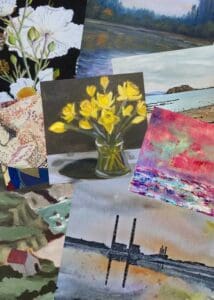Reflecting on Your Artistic Journey: A Look Back and What’s Next
As an artist, every year is an opportunity to reflect on your growth, achievements, and challenges. Whether you’re just starting out or are a seasoned professional, it’s crucial to periodically pause, evaluate where you are, and set new artistic and professional goals. This time of reflection isn’t just about looking back at your past work; it’s about shaping your future—setting goals, adjusting your approach, and planning ahead.
In this blog post, we’ll guide you on how to set meaningful goals for the year ahead, including techniques for achieving them, maintaining motivation, and staying flexible as you adapt to new opportunities and obstacles. Whether you’re exploring new mediums, seeking exhibition opportunities, or growing your online presence, thoughtful planning can help you realize your full potential.
Reflecting on the Past Year: Where Are You Now?
Before diving into goal-setting for the coming year, it’s important to reflect on where you are now. Take time to assess your work from the past year. What were your proudest achievements? What were the challenges or setbacks you encountered? Consider the following questions:
- What new techniques did I learn? Reflecting on your technical growth is essential to understanding how you’ve evolved as an artist.
- Which projects or pieces am I most proud of? Identify the works that made the most impact or brought you the most joy. This will help guide your focus for the future.
- How did I engage with the art community? Whether you participated in exhibitions, worked with other artists, or contributed to discussions online, consider your professional development and networking efforts.
Once you’ve gained insight into your past year, you can set clear and specific goals for the next chapter of your artistic journey.
Setting Artistic and Professional Goals
Goal-setting is a powerful tool to help artists navigate their creative and professional lives. It provides a sense of direction, allows for focused effort, and builds momentum as you tick off achievements. However, successful goal-setting involves more than just writing down what you want to accomplish. It requires clarity, purpose, and a plan of action. Here’s how to set impactful goals for your artistic practice:
1. Create SMART Goals
The SMART framework is a widely recognized method for setting effective goals. SMART stands for Specific, Measurable, Achievable, Relevant, and Time-bound. When setting your artistic and professional goals, consider these factors:
- Specific: What exactly do you want to achieve? Instead of saying, “I want to get better at painting,” a more specific goal would be, “I want to master the technique of watercolor layering.”
- Measurable: How will you track your progress? Set measurable milestones, such as completing a certain number of pieces, applying to five exhibitions, or gaining a specific number of social media followers.
- Achievable: Make sure your goals are realistic given your current resources and time frame. If you’re aiming to showcase your work in an international exhibition, make sure you have a feasible plan for applying and preparing.
- Relevant: Ensure that your goals align with your artistic vision and long-term professional aspirations.
- Time-bound: Set a clear timeline for achieving your goals. For instance, instead of saying “I will participate in an exhibition,” try “I will apply to three exhibitions by June.”
2. Explore New Mediums
One of the best ways to keep your art fresh and exciting is to experiment with new mediums. Whether you’ve always worked in oil paints or graphite, trying something different can spark new ideas and unlock hidden potential. Some examples might include:
- Explore digital art: With the rise of digital platforms, learning to create art digitally can open doors to new ways of working and marketing your art.
- Experiment with mixed media: Combine acrylics with textures like fabric, paper, or even metal to create pieces that are truly one-of-a-kind.
- Try sculpture: If you’re a painter, working with three-dimensional art forms can help you see your creations in a new light.
Expanding your technical range will allow you to tap into new markets and appeal to a broader audience.
3. Increase Your Exhibition Opportunities
Exhibiting your work in public spaces is one of the most effective ways to gain exposure and grow your professional network. Whether you are a local artist or aspire to have a broader reach, participating in more exhibitions can be a powerful goal. Some strategies for getting more exhibitions include:
- Apply to juried shows: Many art festivals and galleries host juried exhibitions where you can submit your work for consideration. Look for juried exhibitions in your area or even in larger cities.
- Collaborate with other artists: Organize your own group show or collaborate with other artists who share similar interests or styles. This is a great way to share the cost of exhibition space and expand your network.
- Get involved in online exhibitions: With more art exhibitions going virtual, take advantage of online platforms to showcase your work to a global audience.
Be proactive about seeking opportunities. Set a goal to apply for a certain number of exhibitions or art fairs by the end of the year.
4. Grow Your Online Presence
In today’s digital age, an online presence is vital for any artist. Social media, websites, and online marketplaces provide a platform for you to connect with collectors, fellow artists, and potential buyers. Goals for expanding your online presence could include:
- Enhancing your social media activity: Set a goal to post regularly on platforms like Instagram, TikTok, or Pinterest. Create engaging content that showcases your creative process, work in progress, and finished pieces.
- Building a website: If you don’t have a website, this should be a priority. Having a dedicated online portfolio gives you more credibility and provides a direct way for buyers to find and purchase your work.
- Join art platforms: Platforms like Irish Artmart allow you to sell and showcase your art to a global audience. Make it a goal to regularly update your listings and interact with potential buyers.
5. Networking and Professional Development
Networking plays a crucial role in advancing your career. Attend local art events, engage with fellow artists online, and collaborate with other creative professionals. You could set goals such as:
- Attend a certain number of networking events: Whether it’s a local artist meet-up or an international conference, setting a goal to attend art-related events will help you connect with others in the art world.
- Find a mentor or coach: Look for an experienced artist or professional in the field who can offer advice, guidance, and support. Setting a goal to develop a mentor relationship can help you make more informed decisions as you navigate your career.
The Importance of Flexibility
While it’s important to set clear goals, it’s equally important to remain flexible. The art world can be unpredictable—opportunities may arise unexpectedly, or you might encounter setbacks that force you to reassess your plans. Flexibility allows you to adapt and keep moving forward even when things don’t go as planned. If something doesn’t work out, don’t be discouraged. Adjust your goals or try a different approach.
Staying Motivated Throughout the Year
Motivation can fluctuate, especially when you’re working toward long-term goals. To stay motivated:
- Break down large goals into smaller steps: Smaller, achievable tasks will help you maintain momentum and prevent burnout.
- Celebrate progress, not just outcomes: Take time to acknowledge your successes along the way. Whether you’ve completed a new painting or secured an exhibition slot, every milestone is worth celebrating.
- Find inspiration in others: Follow artists who inspire you, attend events, and engage with the broader art community to keep your passion alive.
Conclusion: What’s Next?
As you reflect on the past year and plan for the one ahead, take the time to set clear, realistic, and meaningful goals. By setting your artistic and professional objectives, exploring new mediums, expanding your exhibition opportunities, and enhancing your online presence, you’re laying the groundwork for success.
Remember, the key to achieving your goals is consistency, flexibility, and motivation. Embrace the journey, and don’t forget to celebrate every step along the way. Here’s to a year filled with creativity, growth, and new artistic horizons!
*For collaborations, art features, or inquiries, please contact us at [email protected]. Don’t forget to follow us on Instagram, Facebook, Twitter.
Disclaimer: The views and opinions expressed in this article do not necessarily reflect the official policy or position of Irish Artmart.
Irish Artmart – Your Gateway to Artistic Excellence.
Tips to Express Your Creative Vision – Irish Artmart Podcast




